Salvia nemerosa ‘Caradonna
Salvia nemorosa ‘Caradonna’ is a stunning perennial, loved for its deep violet-blue flower spikes and striking dark purple stems. This long-flowering plant adds vertical interest and vibrant color to garden borders from late spring to early autumn. Its aromatic, lance-shaped leaves not only look attractive but also deter pests, making it a low-maintenance favorite.
When it comes to companion planting, Salvia ‘Caradonna’ pairs beautifully with other sun-loving perennials. Consider planting it alongside Rudbeckia, Echinacea, and Achillea for a lively, colorful display. The soft, silver foliage of Stachys byzantina (Lamb’s Ear) or the feathery texture of grasses like Stipa tenuissima create a lovely contrast to Salvia’s upright form. Additionally, Lavender and Nepeta complement its purple hues and attract pollinators.
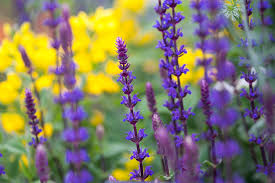
For best results, plant Salvia ‘Caradonna’ in a sunny spot with well-drained soil. It thrives in borders, cottage gardens, and even gravel gardens, where its drought-tolerant nature shines. It’s perfect for adding height and texture to mixed perennial beds, and its vibrant flowers attract bees and butterflies.
Pruning is straightforward. After the first flush of flowers fades, cut back the spent spikes to encourage a second bloom later in the season. In late autumn or early spring, trim the plant back to its base to promote healthy new growth. This will keep the plant compact and vigorous year after year.
You can buy Salvia ‘Caradonna’ from Crocus here to add this beautiful, hardy perennial to your garden.
Verbena bonariensis
Verbena bonariensis is a tall, elegant perennial known for its slender stems topped with clusters of small, violet-purple flowers. It adds a delicate, airy structure to garden borders and is a favorite among pollinators like bees and butterflies. Its long flowering season, from mid-summer to the first frosts, makes it a valuable addition to any garden.
This plant pairs beautifully with other sun-loving perennials and grasses. Echinacea, Rudbeckia, and Gaura complement its height and color, while Stipa tenuissima and Miscanthus add movement and texture. Together, they create a dynamic, naturalistic look that thrives in contemporary or cottage-style gardens.
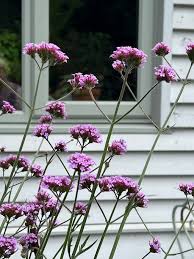
For best results, plant Verbena bonariensis in full sun and well-drained soil. It’s perfect for the middle or back of borders, where its tall, wiry stems won’t overshadow shorter plants. Despite its delicate appearance, it’s surprisingly drought-tolerant and thrives in a variety of conditions.
Pruning is simple. In late winter or early spring, cut back any dead stems to encourage fresh growth. If you want to control self-seeding, deadhead the flowers as they fade. However, many gardeners love its natural ability to self-sow, creating charming, unexpected clusters year after year.
Looking to add Verbena bonariensis to your garden? You can find it at Crocus, a trusted supplier of high-quality plants.
Sedum Autumn Joy
Sedum ‘Autumn Joy’ is a standout perennial, loved for its succulent leaves and long-lasting, rosy-pink flowers. As summer fades, its blooms deepen to a rich copper, adding autumnal warmth to any garden. This hardy, drought-tolerant plant thrives in well-drained soil and full sun, making it a perfect low-maintenance choice for borders or rock gardens.
Pairing Sedum ‘Autumn Joy’ with the right plants enhances its beauty. It looks stunning alongside ornamental grasses like Miscanthus or Panicum, which add movement and texture. Echinacea and Rudbeckia bring complementary splashes of color, while Russian Sage (Perovskia atriplicifolia) adds a cool, silvery contrast. Together, these combinations create a vibrant, late-season display.

Plant Sedum ‘Autumn Joy’ in a sunny spot with good air circulation to prevent mildew. It handles poor, dry soils well, but hates soggy conditions. Once established, it requires little watering, making it perfect for sustainable gardening.
Pruning Sedum is simple. In early spring, cut back the old stems to the base as new growth appears. For neater, more compact growth, pinch back the stems in early summer. However, leaving the dried flower heads through winter adds structure and provides food for birds.
You can purchase Sedum ‘Autumn Joy’ from Crocus, a trusted supplier of high-quality garden plants.
Geum ‘Tangerine Dream’
Geum ‘Tangerine Dream’ is a vibrant perennial that brings a burst of warm, orange hues to your garden. With its semi-double, tangerine-colored flowers, it blooms from late spring into early summer. The delicate, nodding blooms stand on slender, wiry stems above attractive, green foliage. This hardy plant not only adds color but also movement, as its flowers sway gently in the breeze.
When it comes to companion planting, Geum ‘Tangerine Dream’ pairs beautifully with a variety of plants. Consider planting it alongside Salvia nemorosa for a striking contrast of purple and orange. It also works well with Nepeta (catmint), Aquilegia (columbine), and Geranium species, which complement its warm tones and delicate flowers. For a softer look, mix it with grasses like Stipa tenuissima, adding texture and motion to your garden borders.
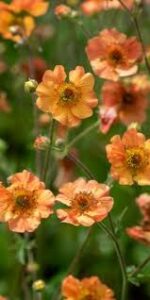
Plant Geum ‘Tangerine Dream’ in a sunny or partially shaded spot with well-drained soil. It thrives in moist, fertile soils but dislikes sitting in waterlogged conditions. Ideal for cottage gardens, mixed borders, or even containers, it brings a cheerful pop of color wherever you place it.
Pruning is simple. After the first flush of flowers fades, deadhead spent blooms to encourage more flowering. Cut back the stems to the base once flowering has finished to promote fresh, healthy foliage. In late autumn, remove any dead or damaged leaves to keep the plant looking
Alchemilla mollis
Alchemilla mollis—commonly known as Lady’s Mantle—is a timeless favorite in gardens, and for good reason. With its soft, velvety, lime-green leaves and frothy yellow-green flowers, it brings a delicate charm to borders and beds. This perennial not only softens the edges of pathways but also adds texture and contrast to more vibrant blooms.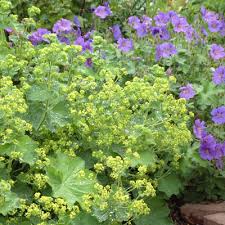
Where to Plant:
Alchemilla mollis thrives in partial shade to full sun, making it a versatile addition to any garden. It prefers moist, well-drained soil but can tolerate drier conditions once established. It’s an excellent ground cover, ideal for cottage gardens, wildlife gardens, or even in urban spaces where a touch of greenery is needed. The leaves catch morning dew or raindrops, creating a magical shimmering effect.
Plants That Pair Well:
Lady’s Mantle pairs beautifully with roses, where its foliage contrasts with bold, colorful blooms. It also looks stunning alongside salvias, geraniums, and lavenders, where its muted green tones complement their vibrant hues. For a softer palette, combine it with hostas and ferns to create a lush, layered look.
If you love bright, cheerful yellow in your garden, Rudbeckia ‘Goldsturm’ is a must-have. This hardy perennial bursts with golden-yellow daisy-like flowers from late summer to early autumn. The dark brown cone-shaped centers create a striking contrast, making it a standout in any border. Its vibrant color and long-lasting blooms add warmth and energy to your outdoor space.
Rudbeckia ‘Goldsturm’
Rudbeckia ‘Goldsturm’ pairs beautifully with other late-summer perennials. Try combining it with Echinacea purpurea for a dynamic mix of yellow and purple. It also looks fantastic alongside grasses like Miscanthus or Panicum, adding texture and movement. For a softer look, mix it with Asters or Sedum ‘Autumn Joy’, which complement its bright hue perfectly.
When it comes to planting, choose a sunny spot with well-drained soil. Rudbeckia thrives in full sun but can tolerate light shade. It’s also drought-tolerant once established, making it an excellent choice for low-maintenance gardens. For best results, plant in groups to create bold, colorful swathes.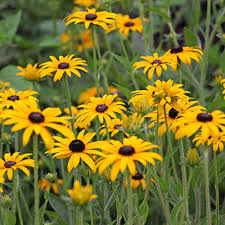
Pruning Rudbeckia ‘Goldsturm’ is simple. Deadhead spent blooms regularly to encourage more flowers throughout the season. In late autumn, once the flowers fade, you can cut the stems back to ground level. However, leaving the seed heads adds winter interest and provides food for birds.
Ready to add a splash of yellow to your garden? You can purchase Rudbeckia ‘Goldsturm’ from Crocus.

Recent Comments